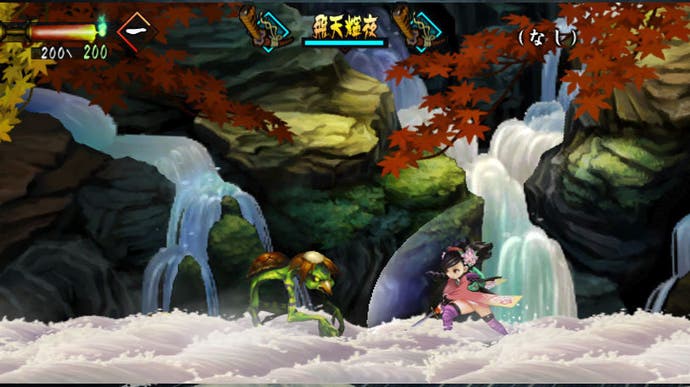Muramasa: The Demon Blade
A thing of beauty is a joy in small doses.
The two different characters, too, control exactly the same, and there's not that much to distinguish their play styles. The swords, of which there are hundreds, are meant to provide variety, but even here there are only two distinct types - the faster tachi and more ponderous odachi. It's not enough to hold your interest for more than an hour or two at a time, and there's no real complexity to the battle system. More distinct playable characters, or more of them, might have made Oboromurumasa as impressive a side-scrolling fighter as it is beautiful.
After each combat situation a screen pops up briefly with a few statistics, just like Okami, and your character sheathes their weapon and runs through to the next area. The levels are sequences of 20 or 30 separate stages, with occasional branching paths leading to doors that might be opened later, or combat bonus stages. It's not an entirely linear game - the story often sends you back to areas you've already visited to unlock previously inaccessible segments.
The stages themselves are unfeasibly good-looking - all gently falling cherry blossoms and bamboo forests that stretch back into infinity, choppy waves rolling across the screen in stop-motion or a sea of Edo-period rooftops in twilight. It's the detail that's truly astounding: the pale moon seeping through charcoal clouds to illuminate a copse of trees, or the silhouettes of people behind their paper screen-doors as you run through a village.
The world is populated by enemies and NPCs suffused with character in their design and animation. The whole thing is crafted with beguiling detail - the way that main character Momohime occasionally glances out towards you from under hooded eyes as she runs, for instance, or the visible glee with which the bosses unleash their attacks, or the entirely lovable eating animations when you visit a little restaurant and order something to eat.

It's just a shame that you sometimes have to run through the same places six or seven times as you make your way through the game's story. Pressing Z brings up a map that clearly indicates wherever you need to go, so you rarely end up lost, but that doesn't stop you from having to backtrack through most of a level that you've already played once or twice, defeating enemies you've fought far too many times. The environments, for all their splendour, repeat themselves rather a lot between levels, and you're less impressed every time you wander through.
It's at least impossible to criticise Oboromuramasa for being overly long in the way that Odin Sphere was. This isn't a plot-based adventure, so while the cut-scenes and voice acting are as high-standard presentation-wise as the rest of the game, the story is largely irrelevant, and certainly not drawn out. The game is over within 10 hours. There's extra longevity if you play through again with the other character or on other difficulty settings, and a few alternative endings to tempt you into doing so, but realistically most people who buy Oboromuramasa will probably find themselves content after one play-through. It's not really long enough to start to get on your nerves.
Oboromuramasa is shallow, rather simple and relatively short-lived, but nonetheless wonderful in its way. As a piece of visual videogame art it's at the very peak of the medium's achievements, along with Okami and Odin Sphere, and it's crafted with such obvious, loving care and attention to detail that it's impossible not to like. If only its combat were as precise and considered as the faultless presentation, this might be an enduring love rather than a fleeting but indisputably beautiful affair.
